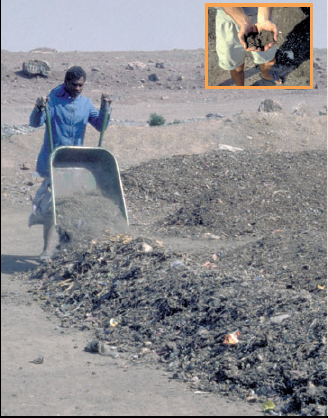Co-composting
|
|
|||||||||||||||||||||||||||
Co-composting is the controlled aerobic degradation of organics, using more than one feedstock (faecal sludge and organic solid waste). Faecal sludge has a high moisture and nitrogen content, while biodegradable solid waste is high in organic carbon and has good bulking properties (i.e., it allows air to flow and circulate). By combining the two, the benefits of each can be used to optimize the process and the product.
There are two types of co-composting designs: open and in-vessel. In open composting, the mixed material (sludge and solid waste) is piled into long heaps called windrows and left to decompose. Windrow piles are periodically turned to provide oxygen and ensure that all parts of the pile are subjected to the same heat treatment. In-vessel composting requires controlled moisture and air supply, as well
as mechanical mixing. Therefore, it is not generally appropriate for decentralized facilities. Although the composting process seems like a simple, passive technology, a well-functioning facility requires careful planning and design to avoid failure.
Contents
Design Considerations
The facility should be located close to the sources of organic waste and faecal sludge to minimize transport costs, but still at a distance away from homes and businesses to minimize nuisances. Depending on the climate and available space, the facility may be covered to prevent excess evaporation and/or provide protection from rain and wind. For dewatered sludge, a ratio of 1:2 to 1:3 of sludge to solid waste should be used. Liquid sludge should be used at a ratio of 1:5 to 1:10 of sludge to solid waste. Windrow piles should be at least 1 m high and insulated with compost or soil to promote an even distribution of heat inside the pile.
| Advantages | Disadvantages/limitations |
|---|---|
| - Relatively straightforward to set up and maintain with appropriate training - Provides a valuable resource that can improve local agriculture and food production |
- Requires a large land area (that is well located) - Long storage times |
Appropriateness
A co-composting facility is only appropriate when there is an available source of well-sorted biodegradable solid waste. Solid waste containing plastics and garbage must first be sorted. When carefully done, co-composting can produce a clean, pleasant, beneficial soil conditioner. Since moisture plays an important role in the composting process, covered facilities are especially recommended where there is heavy rainfall.
Apart from technical considerations, composting only makes sense if there is a demand for the product (from paying customers). In order to find buyers, a consistent and good quality compost has to be produced; this depends on good initial sorting and a well-controlled thermophilic process.
Health Aspects/Acceptance
Maintaining the temperature in the pile between 55 and 60 °C can reduce the pathogen load in sludge to a level safe to touch and work with. Although the finished compost can be safely handled, care should be taken when dealing with the sludge, regardless of the previous treatment. If the material is found to be dusty, workers should wear protective clothing and use appropriate respiratory equipment. Proper ventilation and dust control are important.
Operation & Maintenance
The mixture must be carefully designed so that it has the proper C:N ratio, moisture and oxygen content. If facilities exist, it would be useful to monitor helminth egg inactivation as a proxy measure of sterilization. A well-trained staff is necessary for the operation and maintenance of the facility. Maintenance staff must carefully monitor the quality of the input material, and keep track of the inflows, outflows, turning schedules, and maturing times to ensure a high quality product. Forced aeration systems must be carefully controlled and monitored.
Turning must be periodically done with either a front-end loader or by hand. Robust grinders for shredding large pieces of solid waste (i.e., small branches and coconut shells) and pile turners help to optimize the process, reduce manual labour, and ensure a more homogenous end product.
References and external links
- Hoornweg, D., Thomas, L. and Otten, L. (2000). Composting and Its Applicability in Developing Countries. Urban Waste Management Working Paper Series No. 8. The World Bank, Washington, D.C., US.
- Koné, D., Cofie, O., Zurbrügg, C., Gallizzi, K., Moser, D., Drescher, S. and Strauss, M. (2007). Helminth Eggs Inactivation Efficiency by Faecal Sludge Dewatering and Co-Composting in Tropical Climates. Water Research 41 (19): 4397-4402.
- Obeng, L. A. and Wright, F. W. (1987). Integrated Resource Recovery. The Co-Composting of Domestic Solid and Human Wastes. The World Bank and UNDP, Washington, D.C., US.
- Rouse, J., Rothenberger, S. and Zurbrügg, C. (2008): Marketing Compost, a Guide for Compost Producers in Low and Middle-Income Countries. Eawag (Department Sandec), Dübendorf, CH.
- Available at: sandec.ch
- Strande, L., Ronteltap, M. and Brdjanovic, D. (Eds.) (2014). Faecal Sludge Management. Systems Approach for Implementation and Operation. IWA Publishing, London, UK. (Detailed book compiling the current state of knowledge on all aspects related to FSM)
- Strauss, M., Drescher, S., Zurbrügg, C., Montangero, A., Cofie, O. and Drechsel, P. (2003). Co-Composting of Faecal Sludge and Municipal Organic Waste. A Literature and State-of-Knowledge Review. Eawag (Department Sandec), Dübendorf, CH and IWMI, Accra, GH.
Acknowledgements
The material on this page was adapted from:
Elizabeth Tilley, Lukas Ulrich, Christoph Lüthi, Philippe Reymond and Christian Zurbrügg (2014). Compendium of Sanitation Systems and Technologies, published by Sandec, the Department of Water and Sanitation in Developing Countries of Eawag, the Swiss Federal Institute of Aquatic Science and Technology, Dübendorf, Switzerland.
The 2nd edition publication is available in English. French and Spanish are yet to come.


